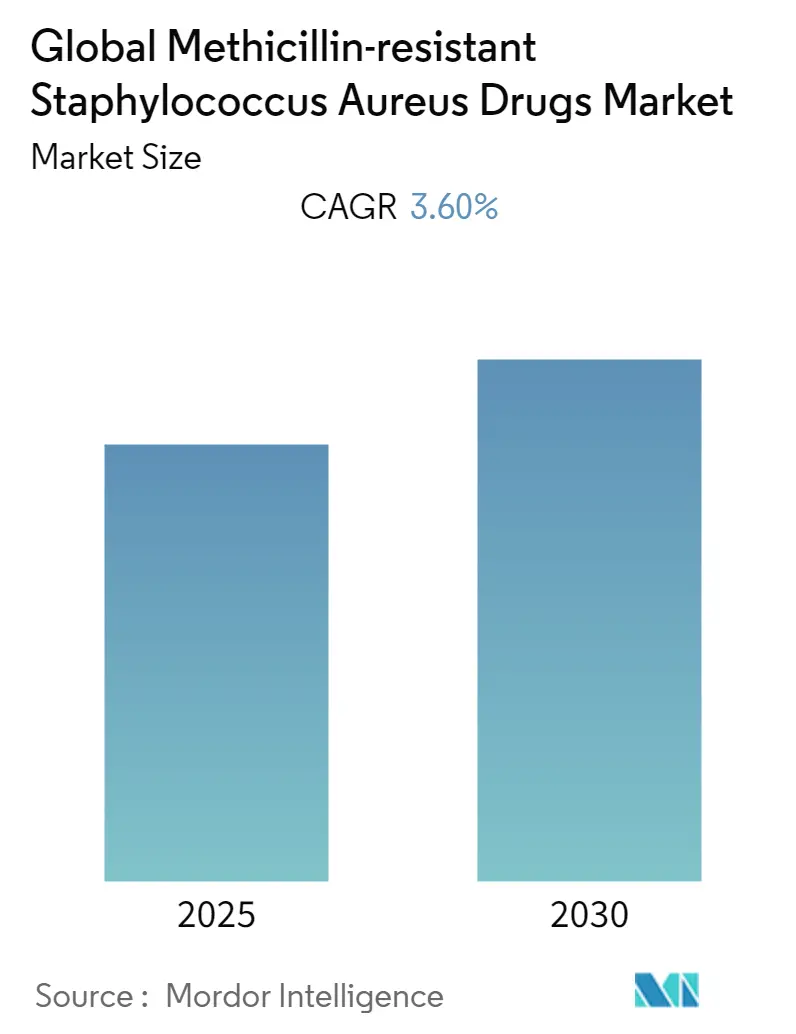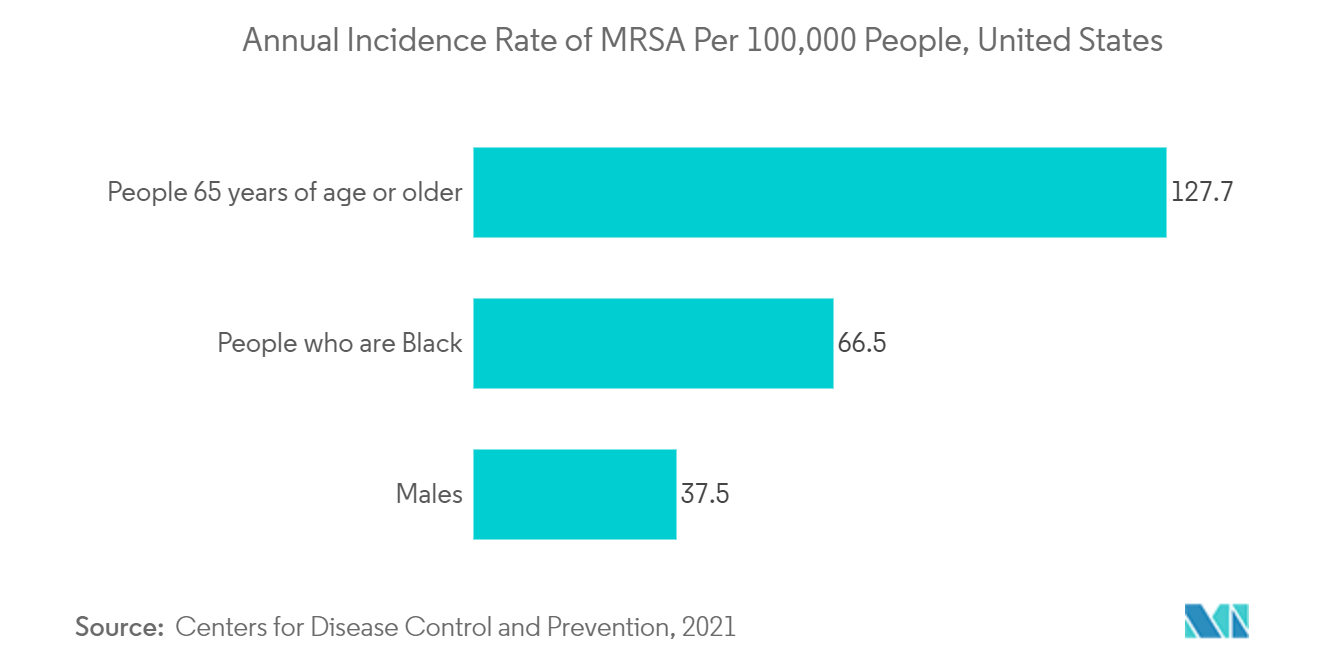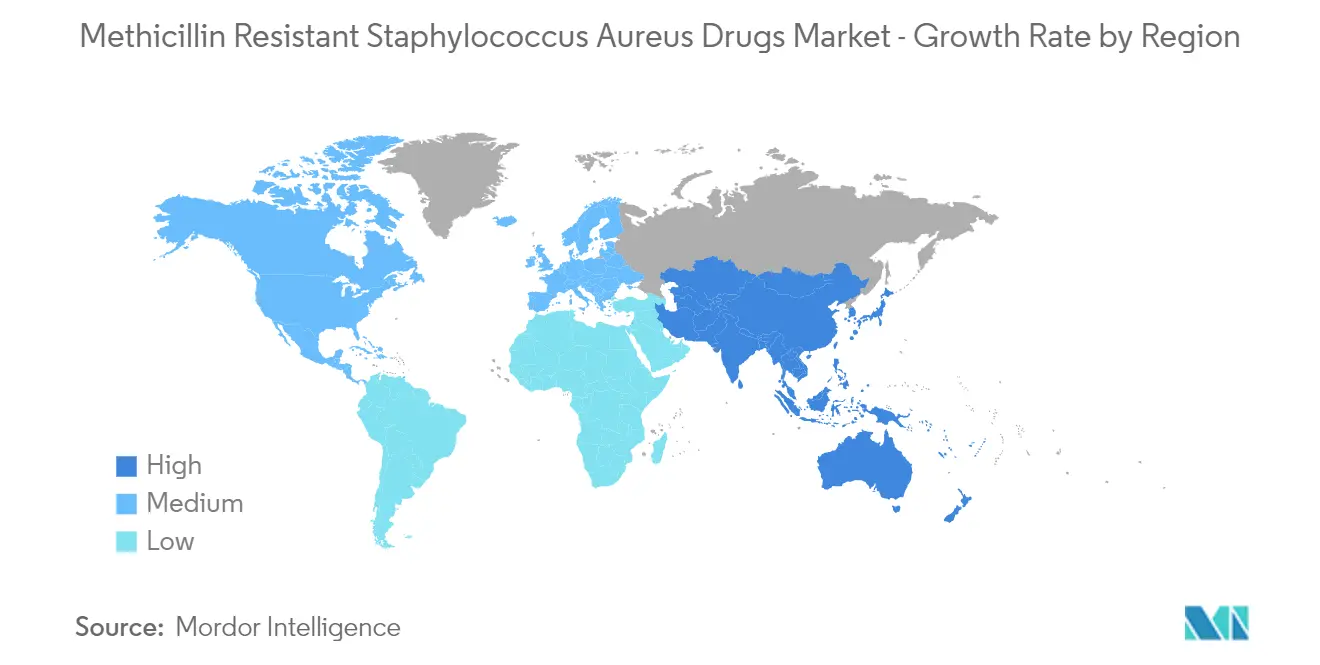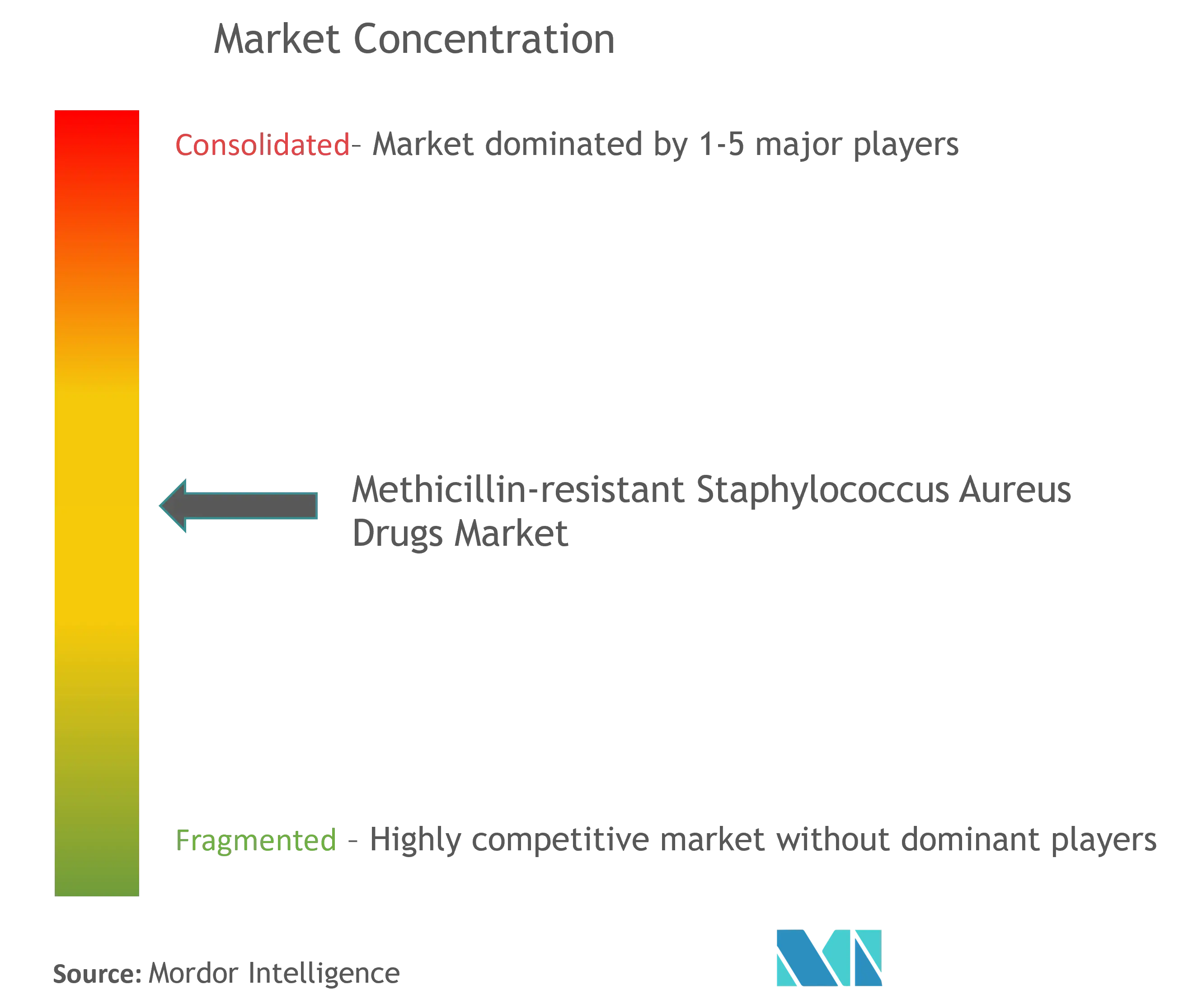Global Methicillin-resistant Staphylococcus Aureus Drugs Market Size and Share

Global Methicillin-resistant Staphylococcus Aureus Drugs Market Analysis by Mordor Intelligence
The Global Methicillin-resistant Staphylococcus Aureus Drugs Market is expected to register a CAGR of 3.6% during the forecast period.
The global healthcare system has faced unprecedented challenges as a result of the coronavirus disease 2019 (COVID-19) pandemic, with opportunistic and secondary infections being one of the most serious issues. Due to exposure to multidrug-resistant organisms in healthcare facilities, the majority of secondary infections develop as nosocomial infections. According to the study "Impact of the COVID-19 Pandemic on the Incidence of Multidrug-Resistant Bacterial Infections in an Acute Care Hospital in Brazil" published in "American Journal of Infection Control" in September 2021, researchers identified 8,869 healthcare-associated infections (HCAI) caused by multidrug-resistant (MDR) bacteria that contributed to the higher mortality rate in Brazil. According to the findings, out of 8,869 HCAIs, of which 2,641 (29.7%) were caused by multidrug-resistant (MDR), and 1,257 (14.1%) were from ICUs. The overall incidence density (ID) of MDR infections increased by 23% during COVID-19. The total per-pathogen study reveals large increases in methicillin-resistant Staphylococcus aureus (MRSA) infections (+94.7%) and carbapenem-resistant Acinetobacter baumannii (CRAB) infections (+108.1%). In the ICU, the overall ID of MDR infections decreased during COVID, but that decline was not significant. The ICU per-pathogen analysis of ID of infection showed significant increases in CRAB and MRSA i.e. +42.0%, and +46.2% respectively. Therefore, the COVID-19 pandemic correlates to an increase in the ID of MRSA both in ICU and non-ICU settings. Thus, the possible outbreaks of MRSA in hospital settings are expected to create lucrative opportunities for the global Methicillin-resistant Staphylococcus Aureus Drugs market growth in the studied period.
The key factors attributing to the growth of the Methicillin-resistant Staphylococcus Aureus (MRSA) drugs market are a rise in the global prevalence of MRSA infections. According to the study "Methicillin-Resistant Staphylococcus Aureus" published in July 2021, the study indicated that MRSA appears to increase mortality and morbidity in geriatric people, nursing home patients, and people with organ dysfunction. People with end-stage liver disease, renal disease, and those hospitalized in the ICU have a significant chance to get hospital-associated MRSA. As per the findings, depending on the patient group and infection site, fatality rates range from 5 to 60%. Furthermore, researchers concluded that despite having no healthcare risks, over 60% of patients get MRSA within 48 hours of hospitalization. Hence, these factors are expected to increase the demand for MRSA drugs, in turn, it will create lucrative opportunities for the taget market growth in the given timeframe.
However, in developing countries, a lack of comprehensive surveillance for MRSA infection is expected to limit the market growth for MRSA drugs during the forecast period.
Global Methicillin-resistant Staphylococcus Aureus Drugs Market Trends and Insights
Lipopeptide Segment is Expected to Hold the Significant Market Share in the Market
The Lipopeptide segment accounts for the major market share owing to the novel antibiotic therapy introduced for MRSA. The therapy includes daptomycin, a lipopeptide class of drug, and linezolid, an oxazolidinone class of antibiotics. Drug-resistant and multidrug-resistant bacteria are becoming a serious public health concern. For instance, according to the study "Prevalence of Methicillin-Resistant Staphylococcus Aureus in a Tertiary Hospital in Nepal" published in the Journal of "Public Health Action" in November 2021, MRSA was found in 1,027 out of the 1,804 patients with S. aureus infection in Nepal. MRSA was shown to be susceptible to vancomycin (100%), linezolid (96%), doxycycline (96%), chloramphenicol (86%), and cotrimoxazole (70%) but resistant to erythromycin (68%), clindamycin (56%), gentamycin (58%), ciprofloxacin (92%), and ofloxacin (92%). MRSA prevalence was greater in outpatients and respiratory samples in 2019 but lower in blood samples. According to the study findings, more than half of individuals with S. aureus infection had MRSA that was resistant to routinely used antibiotics. Thus, the development of new antimicrobials is imperative, and rapid implementation of potential treatment is necessary. Therefore, it is expected to aid the segment's market growth in the studied period.
Moreover, as per the study "Efficacy of Newly Generated Short Antimicrobial Cationic Lipopeptides Against Methicillin-Resistant Staphylococcus Aureus (MRSA)" published in March 2020, the short cationic dialkyl lipopeptides (C10)2-KKKK-NH2 and (C12)2-KKKK-NH2 were tested in vitro and in vivo against clinical methicillin-susceptible S. aureus and MRSA strains. According to the findings, the effect of short lipopeptides in S. aureus was linked to significant morphological structural alterations and cell membrane disruption. The study revealed that both short cationic dialkyl lipopeptides have rapid bactericidal activity in the first 6 hours of treatment, hence, the short lipopeptides were found to be promising novel treatments for MRSA infections. As a result, it is anticipated to support the segment's market expansion over the study period.

North America Dominates the Market and Expected to do Same in the Forecast Period.
North America is expected to dominate the overall Methicillin-resistant Staphylococcus Aureus Drugs market over the forecast period. The factors propelling the market growth are the rising prevalence of MRSA infections and better healthcare infrastructure in the region. Moreover, the rise in government support along with the public health agency to treat MRSA infection in individuals is expected to fuel target market growth. For instance, in October 2020, United States Centers for Disease Control and Prevention (CDC) officials announced the "National Action Plan" to fight antibiotic-resistant infections. According to the CDC, antibiotic-resistant bacteria are responsible for an estimated 35,000 fatalities in the United States each year, and treating them costs the country's healthcare system USD 4.8 billion every year. To overcome this, the National Action Plan for Combating Antibiotic-Resistant Bacteria gives the United States government five years to speed up efforts to prevent the spread of antibiotic-resistant bacteria. In addition to this, the Centers for Disease Control and Prevention (CDC) has set aside more than USD 150 million per year to combat antibiotic resistance problems in all 50 states.
Therefore, such government initiatives along with the rising burden of MRSA infection among the population are anticipated to aid the target market growth over the forecasted period.

Competitive Landscape
Key players operating in the Methicillin-resistant Staphylococcus Aureus Drugs Market include Cumberland Pharmaceuticals Inc., Pfizer Inc., AbbVie Inc., Melinta Therapeutics Inc., Merck & Co Inc., Theravance Biopharma, Basilea Pharmaceutica, AmpliPhi Biosciences Corporation, Teva Pharmaceutical Industries Ltd, Nabriva Therapeutics Plc., Paratek Pharmaceuticals, Inc., Innovation Pharmaceuticals Inc., and Debiopharm International S.A.
Global Methicillin-resistant Staphylococcus Aureus Drugs Industry Leaders
-
Pfizer Inc
-
Cumberland Pharmaceuticals Inc
-
Melinta Therapeutics Inc
-
Merck & Co Inc
-
AbbVie Inc.
- *Disclaimer: Major Players sorted in no particular order

Recent Industry Developments
- In July 2021, Melinta Therapeutics launched KIMYRSA (oritavancin), a lipoglycopeptide antibiotic that delivers a complete course of therapy for acute bacterial skin and skin structure infections (ABSSSI) caused by susceptible isolates of designated Gram-positive microorganisms, including methicillin-resistant Staphylococcus aureus (MRSA).
- In January 2020, Wockhardt announced regulatory approval for two novel antibiotics EMROK (IV) and EMROK O (Oral), for acute bacterial skin and skin structure infections, including diabetic foot infections and concurrent bacteremia in India. The new drug will target superbugs like Methicillin-resistant Staphylococcus aureus (MRSA), which is a leading cause of rising antimicrobial resistance.
Global Methicillin-resistant Staphylococcus Aureus Drugs Market Report Scope
As per the scope of the report, methicillin-resistant staphylococcus aureus (MRSA) is an infection caused by antibiotic-resistant strains of the pathogen Staphylococcus Aureus. The Methicillin-resistant Staphylococcus Aureus Drugs Market is segmented by Drug Class (Oxazolidinones, Lipopeptides, Cephalosporin, Tetracycline, Folate Antagonist, Other Drug Classes), Route of Administration (Oral Administration and Parenteral Administration ), Distribution Channel (Hospital Pharmacies, Retail Pharmacies, and Online Pharmacies), and Geography (North America, Europe, Asia-Pacific, Middle East and Africa, and South America). The market report also covers the estimated market sizes and trends for 17 different countries across major regions, globally. The report offers the market size and forecasts in value (USD million) for the above segments.
| Lipopeptides |
| Oxazolidinones |
| Cephalosporin |
| Tetracycline |
| Folate Antagonist |
| Other Drug Classes |
| Oral Administration |
| Parenteral Administration |
| Hospital Pharmacies |
| Retail Pharmacies |
| Online Pharmacies |
| North America | United States |
| Canada | |
| Mexico | |
| Europe | Germany |
| United Kingdom | |
| France | |
| Italy | |
| Spain | |
| Rest of Europe | |
| Asia-Pacific | China |
| Japan | |
| India | |
| Australia | |
| South Korea | |
| Rest of Asia-Pacific | |
| Middle-East and Africa | GCC |
| South Africa | |
| Rest of Middle-East and Africa | |
| South America | Brazil |
| Argentina | |
| Rest of South America |
| By Drug Class | Lipopeptides | |
| Oxazolidinones | ||
| Cephalosporin | ||
| Tetracycline | ||
| Folate Antagonist | ||
| Other Drug Classes | ||
| By Route of Administration | Oral Administration | |
| Parenteral Administration | ||
| By Distribution Channel | Hospital Pharmacies | |
| Retail Pharmacies | ||
| Online Pharmacies | ||
| Geography | North America | United States |
| Canada | ||
| Mexico | ||
| Europe | Germany | |
| United Kingdom | ||
| France | ||
| Italy | ||
| Spain | ||
| Rest of Europe | ||
| Asia-Pacific | China | |
| Japan | ||
| India | ||
| Australia | ||
| South Korea | ||
| Rest of Asia-Pacific | ||
| Middle-East and Africa | GCC | |
| South Africa | ||
| Rest of Middle-East and Africa | ||
| South America | Brazil | |
| Argentina | ||
| Rest of South America | ||
Key Questions Answered in the Report
What is the current Global Methicillin-resistant Staphylococcus Aureus Drugs Market size?
The Global Methicillin-resistant Staphylococcus Aureus Drugs Market is projected to register a CAGR of 3.6% during the forecast period (2025-2030)
Who are the key players in Global Methicillin-resistant Staphylococcus Aureus Drugs Market?
Pfizer Inc, Cumberland Pharmaceuticals Inc, Melinta Therapeutics Inc, Merck & Co Inc and AbbVie Inc. are the major companies operating in the Global Methicillin-resistant Staphylococcus Aureus Drugs Market.
Which is the fastest growing region in Global Methicillin-resistant Staphylococcus Aureus Drugs Market?
Asia Pacific is estimated to grow at the highest CAGR over the forecast period (2025-2030).
Which region has the biggest share in Global Methicillin-resistant Staphylococcus Aureus Drugs Market?
In 2025, the North America accounts for the largest market share in Global Methicillin-resistant Staphylococcus Aureus Drugs Market.
What years does this Global Methicillin-resistant Staphylococcus Aureus Drugs Market cover?
The report covers the Global Methicillin-resistant Staphylococcus Aureus Drugs Market historical market size for years: 2019, 2020, 2021, 2022, 2023 and 2024. The report also forecasts the Global Methicillin-resistant Staphylococcus Aureus Drugs Market size for years: 2025, 2026, 2027, 2028, 2029 and 2030.
Page last updated on:
Global Methicillin-resistant Staphylococcus Aureus Drugs Market Report
Statistics for the 2025 Global Methicillin-resistant Staphylococcus Aureus Drugs market share, size and revenue growth rate, created by Mordor Intelligence™ Industry Reports. Global Methicillin-resistant Staphylococcus Aureus Drugs analysis includes a market forecast outlook for 2025 to 2030 and historical overview. Get a sample of this industry analysis as a free report PDF download.



